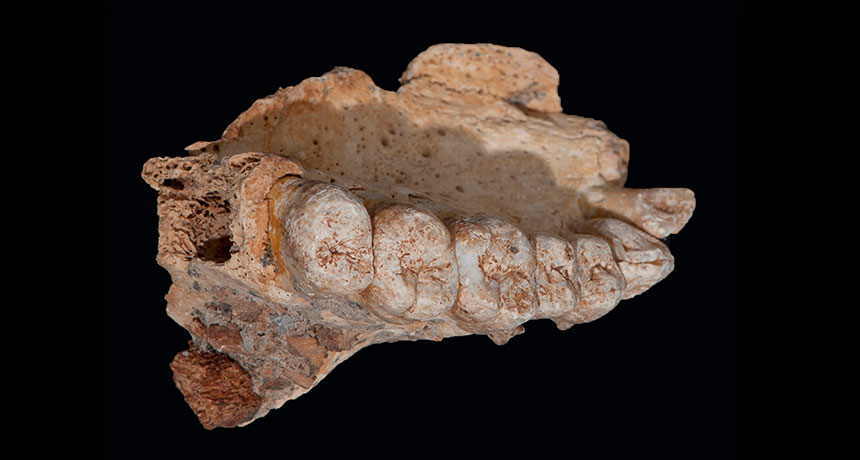An ancient jaw pushes humans’ African departure back in time

A fossil jaw unearthed in Israel is speaking up about when humans departed Africa. The jaw’s message, at least to its finders: That ancient exodus started much earlier than many researchers had assumed.
Misliya Cave on Israel’s Mount Carmel has yielded what its discoverers regard as a partial Homo sapiens jaw with an estimated age of between around 177,000 and 194,000 years old. That indicates that humans could have left Africa and reached the Middle East around 60,000 years earlier than many scientists had assumed. A description and analysis of the fossil appears in the Jan. 26 Science.
Until now, the oldest known H. sapiens fossils outside of Africa, discovered at Israel’s Skhul and Qafzeh Caves, dated to between approximately 90,000 and 120,000 years ago.
The Misliya jawbone “provides the clearest evidence yet that our ancestors first migrated out of Africa much earlier than we previously believed,” study coauthor Rolf Quam of Binghamton University in New York says.
After originating in Africa possibly around 300,000 years ago and inhabiting areas close to the Middle East (SN: 7/8/17, p. 6), H. sapiens likely first reached the Middle East more than 200,000 years ago, proposes an international team of paleoanthropologists led by Quam, Israel Hershkovitz of Tel Aviv University and Gerhard Weber of the University of Vienna. Age estimates for the Misliya jaw jibe with an ancient DNA study published online July 4, 2017, in Nature Communications. Those investigators concluded that H. sapiens left Africa and interbred with Neandertals in Europe between around 219,000 and 460,000 years ago.
Excavations directed by Hershkovitz at Misliya Cave ran from 2001 to 2010. The fossil jaw was discovered in 2002. Stone artifacts unearthed in the same sediment as the fossil jaw included chunks of rock from which sharp flakes were pounded off and used as cutting tools. Some stone flakes found at Misliya Cave were burned, perhaps during the toolmaking process.
Three dating methods, conducted in three different labs, yielded an age estimate for the Misliya jaw. These procedures calculated ages for teeth, sediment that clung to the jaw and burned stone tools.
Hershkovitz suspects that Misliya people’s surprisingly early arrival in the Middle East set the stage for interactions with Neandertals. Although researchers usually attribute the Skhul and Qafzeh finds to H. sapiens that arrived directly from Africa, Hershkovitz thinks that those groups were instead the result of interbreeding between Misliya people and Neandertals. It’s also possible that other humanlike populations, not yet known from fossils, interbred at this geographic crossroads, Hershkovitz says.
Investigators have assumed for decades that, before 120,000 years ago, only Neandertals existed in Israel and other parts of Western Asia. In that scenario, African H. sapiens replaced Neandertals in the Middle East from roughly 120,000 to 90,000 years ago. Other fossil finds suggest Neandertals returned to the region around 80,000 years ago.
The Misliya jaw “doesn’t fit in that long-established picture,” says paleoanthropologist John Hawks of the University of Wisconsin–Madison. But opinions differ on whether the Misliya fossil comes from a H. sapiens.
Story continues below video
Although the Misliya fossil — which includes a partial upper jaw, intact teeth, part of the cheekbone, the roof of the mouth and the bottom of the nasal opening — displays a few features in common with Neandertals and other ancient Homo groups, several dental traits appear only in H. sapiens, Quam says. “That is why we feel confident in our diagnosis of the fossil.”
Rainy periods in Western Asia between 244,000 and 190,000 years ago may have attracted humans from Africa and Neandertals from Europe, suggest paleoanthropologists Chris Stringer and Julia Galway-Witham, both of the Natural History Museum in London. In a commentary in the same issue of Science, they agree that the jaw represents a H. sapiens individual, “suggesting that our species had already left Africa by around 180,000 years ago.”
Hawks isn’t so sure the jaw belongs to H. sapiens. Interbreeding between H. sapiens, Neandertals and perhaps other Homo species in the Middle East could have produced a hybrid Misliya population characterized by humanlike jaws connected to bulkier, Neandertal-style bodies (SN: 10/15/16, p. 22), Hawks says.
Or a Homo species closely related to H. sapiens — but not known from any previous fossils — may have traveled to Misliya Cave, he speculates. “This new discovery from Misliya Cave raises more questions than answers,” Hawks says.